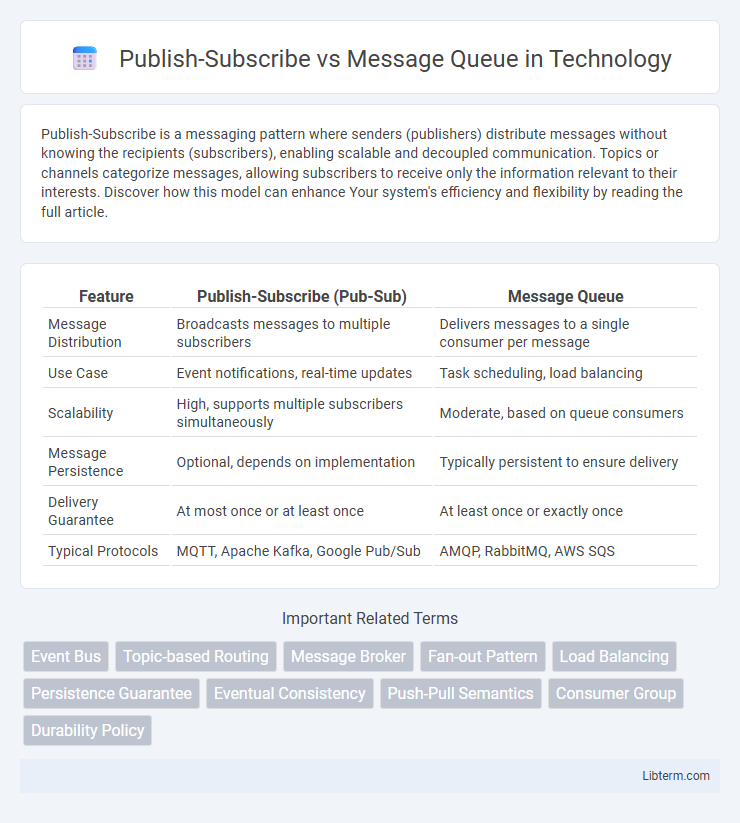Publish-Subscribe is a messaging pattern where senders (publishers) distribute messages without knowing the recipients (subscribers), enabling scalable and decoupled communication. Topics or channels categorize messages, allowing subscribers to receive only the information relevant to their interests. Discover how this model can enhance Your system's efficiency and flexibility by reading the full article.
Table of Comparison
| Feature | Publish-Subscribe (Pub-Sub) | Message Queue |
|---|---|---|
| Message Distribution | Broadcasts messages to multiple subscribers | Delivers messages to a single consumer per message |
| Use Case | Event notifications, real-time updates | Task scheduling, load balancing |
| Scalability | High, supports multiple subscribers simultaneously | Moderate, based on queue consumers |
| Message Persistence | Optional, depends on implementation | Typically persistent to ensure delivery |
| Delivery Guarantee | At most once or at least once | At least once or exactly once |
| Typical Protocols | MQTT, Apache Kafka, Google Pub/Sub | AMQP, RabbitMQ, AWS SQS |
Introduction to Publish-Subscribe and Message Queue
Publish-Subscribe (Pub-Sub) architecture enables multiple subscribers to receive messages from publishers through topics, promoting decoupled and scalable communication. Message Queues facilitate asynchronous communication by storing messages until consumers process them, ensuring reliable message delivery and load balancing. Both models optimize data flow in distributed systems but serve distinct use cases based on timing and consumer patterns.
Core Concepts: How Each Paradigm Works
Publish-Subscribe architecture enables multiple subscribers to receive messages from publishers through topics or channels, promoting decoupled communication where publishers do not need to know the recipients. Message Queue systems operate on a first-in, first-out basis, storing messages in a queue until a consumer retrieves and processes them sequentially, ensuring reliable and ordered message delivery. This fundamental difference highlights how Publish-Subscribe facilitates broadcast-style distribution, while Message Queues emphasize point-to-point communication and message persistence.
Architecture Comparison: Publish-Subscribe vs Message Queue
Publish-Subscribe architecture enables multiple subscribers to receive messages from a single publisher simultaneously, using topics or channels for broadcast communication. In contrast, Message Queue architecture employs a point-to-point model where messages are stored in a queue and delivered to one consumer, ensuring sequential and exclusive processing. Publish-Subscribe supports decoupled scalability by allowing dynamic subscriber addition, while Message Queue prioritizes reliability and order by managing message consumption through queueing mechanisms.
Use Cases and Application Scenarios
Publish-subscribe systems excel in real-time event broadcasting where multiple subscribers need to receive the same message simultaneously, such as in stock market tickers or live sports updates. Message queues are ideal for decoupling producers and consumers in asynchronous workflows, enabling reliable task distribution in order processing or background job execution. Combining both patterns can enhance complex architectures like microservices, where event-driven communication and task scheduling coexist.
Scalability and Performance Differences
Publish-Subscribe systems excel in scalability by allowing multiple consumers to receive messages simultaneously, supporting dynamic subscriber growth without impacting publisher performance. Message Queues optimize performance through point-to-point communication, ensuring reliable and ordered message delivery to a single consumer, which minimizes processing overhead but limits horizontal scaling. Scalability in Publish-Subscribe is enhanced by topic-based filtering and distributed brokers, while Message Queues emphasize throughput and message durability for individual consumers.
Message Delivery Guarantees and Reliability
Message Queue systems ensure reliable message delivery with persistence, acknowledgments, and retries, guaranteeing that messages reach consumers even during failures or downtime. Publish-Subscribe models prioritize real-time distribution to multiple subscribers but may lack strong delivery guarantees, often relying on at-most-once or at-least-once delivery semantics. Message Queues excel in scenarios requiring guaranteed processing and fault tolerance, while Publish-Subscribe suits event dissemination where occasional message loss is acceptable.
Flexibility and System Decoupling
Publish-Subscribe architecture offers greater flexibility by enabling multiple subscribers to receive messages simultaneously, facilitating dynamic scaling and easy integration of new components without altering the message producer. Message Queues provide strong system decoupling through point-to-point communication, ensuring reliable delivery and ordered processing but often limit flexibility due to one-to-one message routing. Combining both paradigms can optimize system design by balancing flexible event distribution with robust decoupling and message persistence.
Popular Technologies and Tools
Publish-Subscribe systems like Apache Kafka and Google Cloud Pub/Sub enable real-time, scalable event distribution to multiple subscribers, making them ideal for streaming data and event-driven architectures. Message Queue technologies such as RabbitMQ, Amazon SQS, and Apache ActiveMQ focus on reliable task processing and workload distribution through point-to-point messaging patterns, ensuring message durability and ordered delivery. Both paradigms offer critical features for different use cases, with Kafka excelling in high-throughput event streaming and RabbitMQ providing robust support for complex routing and transactional message handling.
Challenges and Limitations
Publish-Subscribe systems face challenges in ensuring message delivery guarantees and managing scaling complexities due to many-to-many communication patterns, often leading to difficulties in handling message ordering and duplicate messages. Message Queues, while providing reliable point-to-point communication with guaranteed message processing, can suffer from bottlenecks and single points of failure if not properly distributed or replicated. Both models require robust infrastructure to handle fault tolerance, latency issues, and dynamic scaling to maintain performance under varying loads.
Choosing the Right Messaging Pattern
Choosing the right messaging pattern depends on the application's communication needs: Publish-Subscribe excels in broadcasting messages to multiple subscribers simultaneously, ideal for real-time updates and event-driven architectures. In contrast, Message Queue ensures reliable, ordered processing by decoupling sender and receiver, making it suitable for task distribution and load balancing. Evaluating factors like message delivery guarantees, scalability requirements, and system complexity helps determine whether a Publish-Subscribe or Message Queue pattern aligns best with your use case.
Publish-Subscribe Infographic

 libterm.com
libterm.com